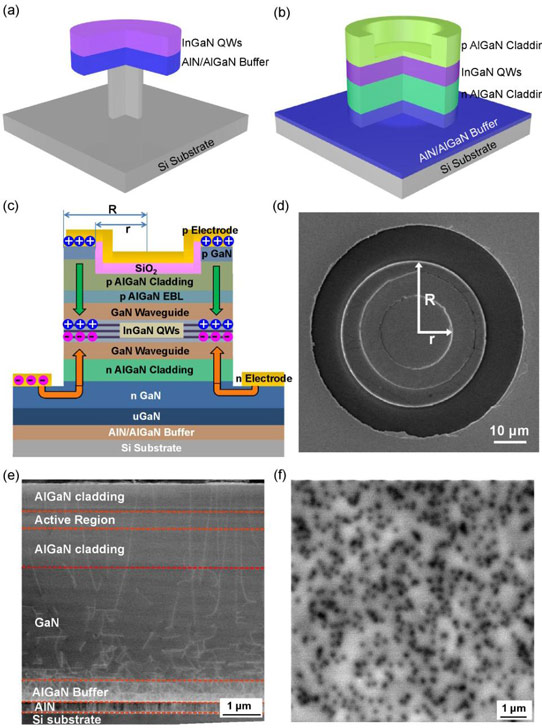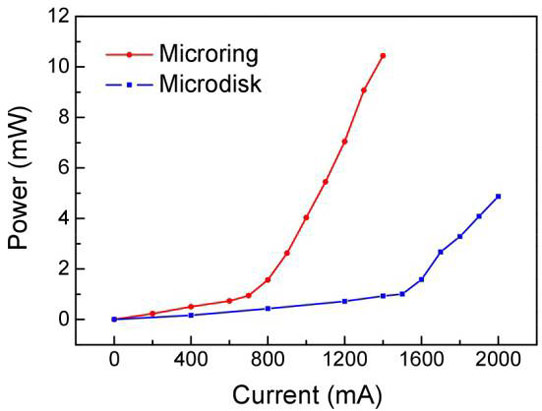- News
12 March 2018
Room-temperature electrically pumped indium gallium nitride microdisk laser
Researchers in China have successfully fabricated an indium gallium nitride (InGaN) microdisk laser on silicon that operated at room temperature under electrical pumping [Meixin Feng et al, Optics Express, vol26, p5043, 2018]. “This is the first observation of electrically pumped lasing in InGaN-based microdisk lasers grown on Si at room temperature,” the team from Suzhou Institute of Nano-Tech and Nano-Bionics, University of Science and Technology of China, and Changchun Institute of Optics Fine Mechanics and Physics, writes.
Laser devices are needed on silicon to power photonics handling through silicon waveguides for high-speed data transmission and processing combined with CMOS electronics. Generally, reported microdisk lasers on silicon have been optically pumped, reducing their usefulness.
Microdisk lasers use whispering gallery modes of light reflecting/echoing around a circular structure to create a resonant cavity for laser excitation that can efficiently couple to on-chip waveguides.

Figure 1: (a) Conventional ‘mushroom-like’ InGaN-based microdisk laser on Si with undercut structure and (b) ‘sandwich-like’ InGaN micro-ring laser grown on Si with AlGaN cladding layers. (c) Schematic structure of InGaN micro-ring laser. (d) Scanning electron microscope image. (e) Cross-sectional high-angle annular dark-field scanning transmission electron microscope (STEM) image. (f) Panchromatic cathodoluminescence image of GaN film grown on silicon, giving a density of threading dislocations (TDs) of ~6x10^8/cm2.
The researchers used a sandwich structure on silicon (Figure 1), rather than the more usual stem-and-cap mushroom format normally employed for optically pumped microdisk lasers. The team adopted the sandwich format to give more robustness and to reduce the electrical and thermal resistance of the n-side of the device.
Since aluminium gallium nitride (AlGaN) has a lower refractive index than GaN, it was used as lower cladding, confining most of the optical field away from the absorptive highly defective buffer.
However, the sandwich structure did require a thicker buffer structure to overcome the 17% lattice mismatch and 54% thermal expansion coefficient difference. The buffer layers consisted of 370nm AlN nucleation, 280nm Al0.35Ga0.65N, 415nm Al0.17Ga0.83N, and 1μm GaN.
The n-contact layer was 1.6μm n-GaN. The n-side continued with 1.3μm Al0.07Ga0.93N cladding and a 80nm GaN lower waveguide.
The active region consisted of three well/barrier pairs of 2.5nm/7.5nm In0.1Ga0.9N/In0.02Ga0.98N. The upper 60nm GaN waveguide was undoped. The p-type layers were 20nm Al0.2Ga0.8N electron blocking (EBL), 100x(3nm/3nm) Al0.11Ga0.89N/GaN superlattice cladding, and 30nm GaN contact.
Circular microdisks were fabricated using a nickel mask and dry etching. Sidewall damage was removed with tetramethyl ammonium hydroxide (TMAH) wet etching, smoothing the surface and reducing surface recombination centers and optical losses. The TMAH treatment reduced threshold currents for microdisks from ~1500mA to ~1000mA.
The researchers also fabricated micro-ring devices that concentrated current injection at the periphery for more efficient excitation of whispering gallery modes (Figure 2). This also avoids Joule heating of the central region that can degrade performance. The micro-ring injection was ensured by removing the p-GaN and part of the p-AlGaN/GaN superlattice cladding from, and by depositing silicon dioxide (SiO2) in, the center of the disk.

Figure 2: Peak light output power of InGaN-based micro-ring laser and microdisk laser grown on silicon measured under various 400ns, 10kHz pulsed currents at room temperature.
The researchers comment: “Compared with the conventional microdisk resonators, micro-ring resonators have more compact cavity volume and better high-speed modulation characteristics due to less effect of carrier space hole-burning and diffusion.”
A micro-ring laser with outer and inner radii of 10μm and 5μm, respectively, emitted a peak wavelength of 412.4nm with 0.4nm full-width at half maximum (FWHM) under 250mA pulsed current at room temperature. Over a range of devices, the threshold occurred between 200mA and 450mA. Without TMAH treatment, micro-ring lasers had a threshold of ~800mA.
Silicon substrate InGaN AlGaN Microdisk laser
https://doi.org/10.1364/OE.26.005043
The author Mike Cooke is a freelance technology journalist who has worked in the semiconductor and advanced technology sectors since 1997.


